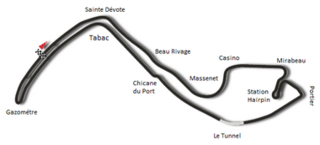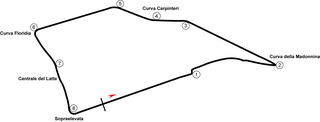
Vanwall was a motor racing team and racing car constructor that was active in Formula One during the 1950s. Founded by Tony Vandervell, the Vanwall name was derived by combining the name of the team owner with that of his Thinwall bearings produced at the Vandervell Products factory at Acton, London. Originally entering modified Ferraris in non-championship races, Vanwall constructed their first cars to race in the 1954 Formula One season. The team achieved their first race win in the 1957 British Grand Prix, with Stirling Moss and Tony Brooks sharing a VW 5, earning the team the distinction of constructing the first British-built car to win a World Championship race. Vanwall won the inaugural Constructors' Championship in Formula One in 1958, in the process allowing Moss and Brooks to finish second and third in the Drivers' Championship standings, winning three races each. Vandervell's failing health meant 1958 would be the last full season; the squad ran cars in a handful of races in the following years, but finished racing in 1961.
The Alta Car and Engineering Company was a British sports and racing car manufacturer, commonly known simply as Alta. Their cars contested five FIA World Championship races between 1950 and 1952, as well as Grand Prix events prior to this. They also supplied engines to a small number of other constructors, most notably the Connaught and HWM teams.

The 1958 Argentine Grand Prix was a Formula One motor race held on 19 January 1958 at Autodromo Municipal Ciudad de Buenos Aires Circuit. It was race 1 of 11 in the 1958 World Championship of Drivers and race 1 of 10 in the 1958 International Cup for Formula One Manufacturers. The race was the sixth Argentine Grand Prix. It was held on the #2 variation of the circuit. The race was held over 80 laps of the four kilometre circuit for a total race distance of 313 kilometres.

The 1958 Monaco Grand Prix was a Formula One motor race held on 18 May 1958 at Monaco. It was race 2 of 11 in the 1958 World Championship of Drivers and race 2 of 10 in the 1958 International Cup for Formula One Manufacturers. The race was the 16th Monaco Grand Prix and was held over 100 laps of the three kilometre circuit for a total race distance of 314 kilometres.

The 1958 Belgian Grand Prix was a Formula One motor race held on 15 June 1958 at Spa-Francorchamps. It was race 5 of 11 in the 1958 World Championship of Drivers and race 4 of 10 in the 1958 International Cup for Formula One Manufacturers. The race was the 19th Belgian Grand Prix and it was held over 24 laps of the 14 kilometre circuit for a race distance of 339 kilometres.

The 1957 Formula One season was the 11th season of FIA Formula One motor racing. It featured the 1957 World Championship of Drivers, which commenced on 13 January 1957 and ended on 8 September after eight races. Juan Manuel Fangio won his fourth consecutive title, his fifth in total, in his final championship. A feat that would not be beaten until Michael Schumacher in 2003. The season also included numerous non-championship races for Formula One cars.

Peter John Collins was a British racing driver. He was killed in the 1958 German Grand Prix, just weeks after winning the RAC British Grand Prix. He started his career as a 17-year-old in 1949, impressing in Formula 3 races, finishing third in the 1951 Autosport National Formula 3 Championship.
Charles Anthony Standish Brooks was a British racing driver also known as the "Racing Dentist". He participated in 39 Formula One World Championship Grands Prix, competing for the first time on 14 July 1956, and achieved six wins, 10 podium finishes and 75 career points. He was third in the World Drivers' Championship in 1958 with Vanwall and second in 1959 with Ferrari. He also scored the first win by a British driver in a British car in a Grand Prix since 1923, driving a Connaught at Syracuse in 1955 in a non-championship race.
Stuart Nigel Lewis-Evans was a British racing driver from England. He participated in 14 Formula One World Championship Grands Prix, debuting on 19 May 1957. He achieved two podiums, and scored a total of 16 championship points. He also achieved two pole positions.

Connaught Engineering, often referred to simply as Connaught, was a Formula One, Formula Two and sports car constructor from the United Kingdom. Their cars participated in 18 Grands Prix, entering a total of 52 races with their A, B, and C Type Formula 2 and Formula 1 Grand Prix Cars. They achieved 1 podium and scored 17 championship points. The name Connaught is a pun on Continental Autos, the garage in Send, Surrey, which specialised in sales and repair of European sports cars such as Bugatti, and where the cars were built.

The 1958 Moroccan Grand Prix, formally the VII Grand Prix International Automobile du Maroc, was a Formula One motor race held at Ain-Diab Circuit, Casablanca on 19 October 1958, after a six-week break following the Italian Grand Prix. It was race 11 of 11 in the 1958 World Championship of Drivers and race 10 of 10 in the 1958 International Cup for Formula One Manufacturers. It is the only time Morocco has hosted a World Championship Grand Prix.

The Mercedes-Benz W196 was a Formula One racing car produced by Mercedes-Benz for the 1954 and 1955 F1 seasons. Successor to the W194, in the hands of Juan Manuel Fangio and Stirling Moss it won 9 of 12 races entered and captured the only two world championships in which it competed.
Rob Walker Racing Team was a privateer team in Formula One during the 1950s and 1960s. Founded by Johnnie Walker heir Rob Walker (1917–2002) in 1953, the team became F1's most successful privateer in history, being the first and only entrant to win a World Championship Formula One Grand Prix without ever building their own car.

The Maserati 250F was a racing car made by Maserati of Italy used in '2.5 litre' Formula One racing between January 1954 and November 1960. Twenty-six examples were made.

The Ferrari 500 was a Formula 2 racing car designed by Aurelio Lampredi and used by Ferrari in 1952 and 1953, when the World Championship was run to F2 regulations.

Guy Anthony "Tony" Vandervell was a British industrialist, motor racing financier, and founder of the Vanwall Formula One racing team.

The Cooper T81 is a Formula One car produced by the Cooper Car Company for the 1966 Formula One season. It represented something of a comeback for Cooper's fortunes, winning two races and enabling Cooper to finish third in the Constructors' Championship in 1966 and 1967.

The Cooper T51 was a Formula One and Formula Two racing car designed by Owen Maddock and built by the Cooper Car Company for the 1959 Formula One season. The T51 earned a significant place in motor racing history when Jack Brabham drove the car to become the first driver to win the World Championship of Drivers with an engine mounted behind them, in 1959. The T51 was raced in several configurations by various entrants until 1963 and in all no less than 38 drivers were entered to drive T51s in Grand Prix races.

The BRM P25 was a Formula One racing car raced from 1956 to 1960 and the second car produced by the British Racing Motors consortium. After the failure of the complex BRM V16, the P25's design emphasized simplicity. The car was fitted with a 2.5-litre straight-4 engine, producing some 275 horsepower. The P25 would be the foundation of BRM's successes in the late 1950s and early 1960s.

The 1955 Syracuse Grand Prix was a Formula One race, held on 23 October at the Syracuse Circuit in Sicily. The race was won by Tony Brooks, in his first Formula One race, driving a Connaught type B. This was the first international Grand Prix win for a British car since the 1924 San Sebastián Grand Prix.
















